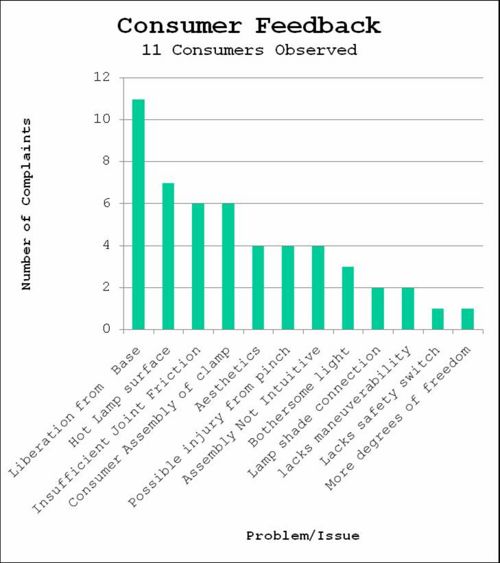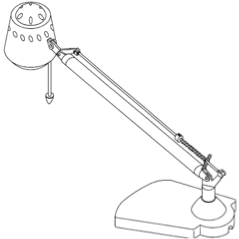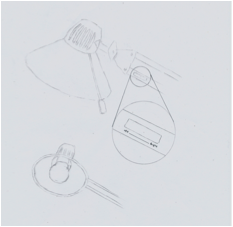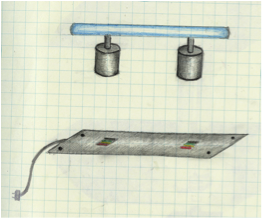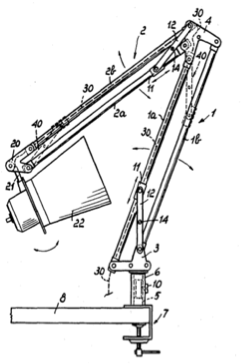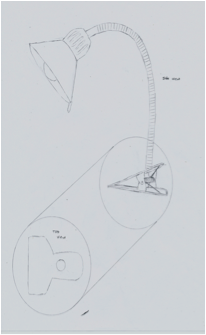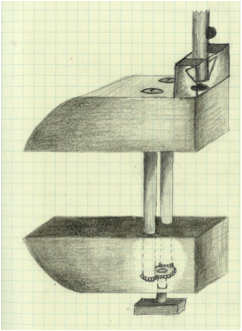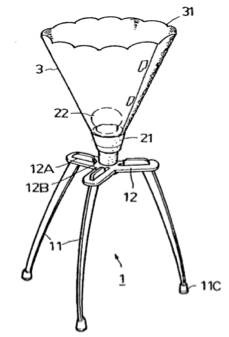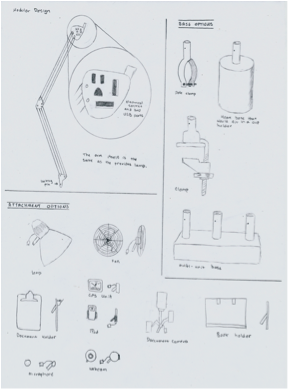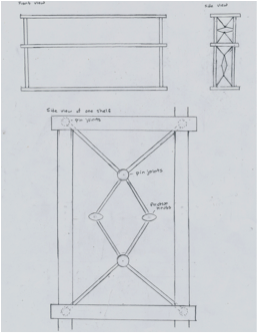Lamp stand mechanical arm redesign
From DDL Wiki
Contents |
Executive Summary
Design Objectives
The main design problem with this desk lamp is stability while maneuvering the lamp to the desired position. According to research (explained in detail below), the main issue with this desk lamp is stability during use. The lamp either liberates itself from the base during use or it does not stay in the desired location. Both of these issues account for roughly a 31% of the complaints with the lamp. The need to address the issue of stability while maneuvering is, therefore, the primary design problem.
The secondary design problems with the desk lamp would be the high temperature of the lamp shade during use and the difficult assembly of the clamp when attaching the base to the surface. These together account 25% of the complaints with the lamp (There were more consumers concerned with the temperature of the surface rather than the clamp attachment issue).
Results of Research
The graph to the right shows the result of our ethnographic study how 11 users interacted with the lamp and their feedback or concerns. These people are all part of the focus market segment of students, universities and offices.
The participants agreed unanimously that the liberation of the base during maneuvering is an problem with this lamp; one even citing it as the prime reason she doesn’t buy this type of lamp. The users in the study either experienced the liberation issue while maneuvering the lamp or had prior experience with this lamp where it liberated itself from the base. 11% of the consumers agreed that the lack of friction in the joints is also a concern when maneuvering the lamp; the lack of friction overtime this will prevent the lamp from staying where it is placed. The need to tighten the friction knobs just right also caused a lack of sufficient friction because the users did not intuitively know when sufficient friction was reached.
14% of the participants also expressed concern about the temperature of the lamp shade. This is because most participants hold the lamp shade while maneuvering the lamp. A hot surface would then eliminate all degrees of freedom associated with the lamp head. 11% also had difficulty assembling the clamp that secures the base to the surface. This was mainly due to the complex “look” of the base and that one must use 2 hands to clamp the base to the surface
The other responses occurred in less than half the complaints about the product. Some of these issues will be addressed indirectly through the other design improvement, but these are not the focus of our efforts.
Patent Search & Key Findings
Links to Existing Patents
Please put some pros and cons for each
Key Ideas
This section should include things like...most of the designs address issue X, but don't address issue Y
Description of Solutions
Modular Base
This design concept features modular attachments on both upper and lower termini at the ends of the arm. On the upper termini there are 2 USB ports and one electrical outlet. allowing for a variety of attachment options, each serving a different niche group. This would increase the desirability of our product because it would allow the consumer to customize their own desk accessory, giving them as much or as little as they please.
The base is dealt with in a similar manner. It has modular attachments that serve different purposes depending on the users need. The issue of the arm liberating from the base is addressed by using a locking pin. The clamp also has a wider footprint on the table allowing for increased stability when maneuvering the product. The difficulty of the consumer assembly of the clamp is also taken care of because the clamp in this design eliminates unnecessary holes. This would serve to increase the intuitiveness of the assembly procedure for the consumer.
Positive Features
- Reaches many markets because of many functions
- Small problems with previous mechanical parts are solved (Locking pin in base prevents the pieces from liberating on their own)
- Large number of possible attachments allow for further innovation and marketing
Negative Features
- Many parts make compact packaging more difficult & limits number of standard attachment options
- Heavy base is cumbersome
- Storage needed for bases and attachments that are not currently being used
- Joints are not improved so long term life is not extended, leading to decreased ability.
- Issues with temperature of lamp surface not addressed
Market Analysis
Gwendolynn this is your part here. Here put things like how for the touch switch the elderly would like this a lot & for the modular one that each extra module could add more possibilities for extra clients
Goose Neck Lamp
The Goose Neck Lamp solution has a lamp on the end of Goose Neck. The method chosen to attach this design to the bases was a simple clamp. This solution addresses various concerns of the customer. Given the right surface to connect to, the Goose Neck is very stable while being maneuvered into position. The clamp now requires virtually no assembly, addressing the complexity in the prior clamp. The high temperatures seen in the current design would be indirectly addressed by attaching a handle to the shade that allows the user to move the lamp without touching the lamp. A foil inner liner for the lamp shade also helps to reflect radiation and keep the lamp shade as cool as possible directly addressing the customer concern with the high temperatures seen in the research.
Positive Features
- Cool to the touch due to ceramic insulation
- Directs heat away from user
- Handle allows for repositioning without needing to touch the lamp hood
Negative Features
- Limited range of locations it can safely be attached to
- Ceramic to metal attachment will be difficult to accomplish
- Clip may have a tendency to fall apart
Market Analysis
This lamp can be marketed to universities, college students, and corporations. The market research showed that many people did not like the original lamp because the hood got hot and burned them. The handle satisfies that safety issue.
Magnetic Base with Current
The Magnetic Base with Current solution has a metal base that can be screwed to almost anything and has an LED light that magnetically attaches to the base. The light could come with multiple bases so that the consumer could have a base screwed to a desk, a wall, or a bed headboard. The electric circuit is completed when the magnetic posts attach to the base. The magnetic posts have a wire that goes through the center to the light. Four electrical strips on the base and the posts make it so the circuit will only be completed when they line up correctly. This makes the lamp very safe, keeping the user from a possible electrical shock.
Positive Features
- The LED light is long-lasting and doesn't get hot
- With multiple bases, on light can be moved to many locations in a room
- It is very easy to use since the magnet does the work of connecting the base to the light
Negative Features
- Creating a circuit to go through the base and be completed by the touch of the light posts could be difficult to make
- The magnets would have to be very strong and could attract other metal objects
- This could be expensive to make due to the LED light and the special electric circuit
- Possibility to pinch user when connecting the two magnets
Market Analysis
The user research showed that many people were frustrated with the complexity of the base and the arm joints of the original lamp. They also did not like that the lamp hood got hot and burned them. This design idea satisfies those needs because the base just needs to be screwed down to a wooden desk or headboard. It is very simple to connect the light to the base because the connection is magnetic. However, this design may not be ideal for the college student and university market because the production costs may be too high.
Ceramic Lamp Shade
Positive Features
Negative Features
Market Analysis
Pugh Charts
Lighting
The weight is higher for the good lighting parameter because this specific pugh chart focuses on design ideas pertaining to lighting. Design 1 stays with the same idea as the Standard design, but is more flexible, safer, and has better lighting. Design 2 goes in a different lighting direction than the Standard Design and has much better lighting. Both designs are better than the Standard Design and have very close scores.
Mechanical
The weight is higher for the flexible parameter because this specific pugh chart focuses on design ideas pertaining to the mechanical aspect of the lamp. Design 1 uses a different arm than the Standard Design. The gooseneck allows the lamp to move and stay in almost any direction. Design 2 focuses on improving the base of the Standard Design. The base keeps the lamp arm from falling out and has a more secure hold on the surface it attaches to. Both designs are much better options than the Standard Design.
New Designs
The weight is higher for the easy to use parameter because this specific pugh chart focuses on design ideas that are completely new and focus on the consumer's needs. Design 1 uses interchangeable bases and payloads, which creates more functions for the arm and gives the consumer many options. Design 2 goes in a completely different direction than a lamp and focuses on the target market's needs. Since the target market is college students and universities, adjustable shelves are a great addition to any dorm room or office. However, Design 2 doesn't score high in safety or lighting, which gives it a low score in comparison to the Standard Design and Design 1.
